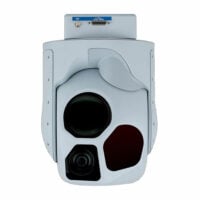Infrared (IR) is a form of electromagnetic radiation that is invisible to the human eye. All objects emit radiation relative to their temperature, and most of this radiation is in the infrared spectrum. This means that infrared detectors can be used to distinguish objects such as people, living things, aircraft and vehicle engines, and weapons.
Infrared Cameras
Thermal imaging cameras such as forward-looking infrared (FLIR) cameras can be used to sense infrared radiation levels and map these to an image or video output. They may detect long-wave (LWIR), medium-wave (MWIR) or short-wave (SWIR) infrared, depending on the application.
IR cameras can be used for a wide variety of military applications such as ISR (intelligence, surveillance and reconnaissance), navigation and operating vehicles at night, and seeing through smoke, fog and dust. Thermographic cameras may be integrated into gimbals along with visible cameras to provide EO/IR (electro-optical/infrared) systems for aircraft, vehicles, vessels, and static defenses such as counter-UAS systems.
Infrared Sensors
IR sensors may be cooled or uncooled. Cooled systems use cryogenics to keep them at an extremely low temperature. They provide high-quality, low-noise imagery and are highly sensitive to minute temperature differences, but are more expensive than uncooled systems. Due to the extra cooling equipment, they also have a larger SwaP (size, weight and power) footprint.
Night vision goggles, binoculars and weapons sights may also use thermal imaging technology to capture infrared radiation, allowing ground troops and special forces to operate at night.
Infrared Jamming & Countermeasures
Infrared sensors are used on heat-seeking missiles to detect heat sources such as aircraft engines. These infrared homing missiles can then steer themselves towards the target by tracking this heat source. Infrared countermeasures include flares, which provide alternative IR sources to confuse the missile and cause it to miss its target, and infrared jammers, which aim to overpower the missile’s IR detector with high-powered signals.





















